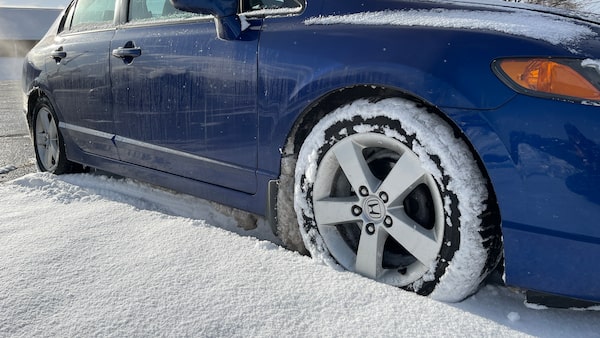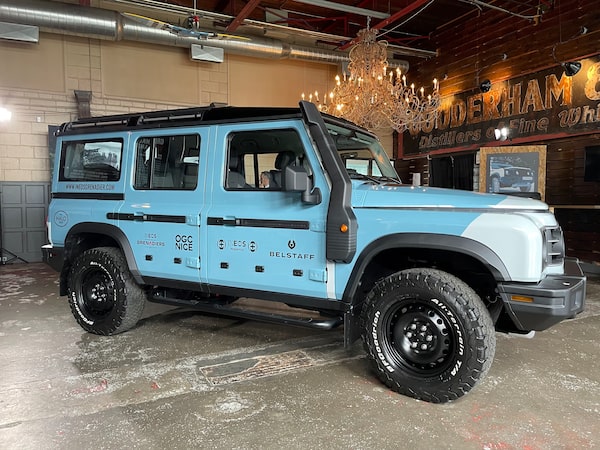6. Here are the electric SUVs worth waiting for
ANDRONIKI CHRISTODOULOU/Reuters
Reader interest in electric vehicles is climbing quickly, especially when gas prices spike as they did this year. At the same time, automakers are launching dozens of new EVs, with many of them being SUVs, which are really popular with Canadians. In January, Petrina Gentile and Mark Richardson analyzed the electric SUVs they are excited for.
5. ‘Sitting ducks’: EV charging stations leave some drivers feeling exposed

Petrina Gentile/The Globe and Mail
Globe Drive writers drive a lot of cars and have been at the forefront of the shift to electric vehicles. They are some of the first to experience the thrill of instant torque on a new car, but also the growing pains of the charging ecosystem. Charging an EV is more complicated and time consuming than pulling up to a well-lit service station with cameras and attendants nearby and refuelling in mere minutes. Petrina Gentile wrote about her experience not feeling safe while sitting in an expensive car, tethered to a charger and what drivers and the charging networks can do to improve the situation.
4. How all-weather tires stack up against all-season and winter tires in a snow storm

Mark Richardson/The Globe and Mail
When the first snowfall hit the Greater Toronto Area this past fall, Mark Richardson wasn’t prepared. Between him and his wife they had one car with all-season tires and one car with all-weather tires, which made for a perfect opportunity to use the early snow to test the difference in unfavourable conditions.
3. Why do we need winter tires now, but we didn’t a few decades ago?
Christinne Muschi/Christinne Muschi/The Globe and
As winter approached, Lou Trottier provided some historical context on how tires have changed over the last few decades. Basically, it came down to making tires smoother to reduce fuel consumption. As the rolling resistance of all-season tires decreased, so did their usability as a year-round tire. Snow tire sales climbed as drivers found they were no longer comfortable driving in blustery conditions.
2. Pickup trucks and big SUVs cost us all more. It’s time to make these drivers pay their fair share
Bloomberg
While Ontario scrapped vehicle registration fees altogether, in May Washington’s city council proposed increasing registration fees for vehicles based on weight. Matt Bubbers wrote a column about the proposal, arguing that provinces should take note because “the sheer size of these huge machines is bad for pedestrian safety, the environment and our streets and bridges.”
1. New SUV makes Canadian debut, hoping to sway Bronco, Defender and G-Class buyers

Matt Bubbers/The Globe and Mail
In early June, the Ineos Grenadier, an unabashedly utilitarian new SUV that picks up where classic off-roaders like the old Land Rover Defender or vintage Mercedes G-Class left off, made its Canadian debut in Toronto. Matt Bubbers was there and spoke with potential buyers.
Many of our most-read stories each year come from questions readers send in, particularly about rules of the road. Every week, Jason Tchir calls experts and often finds the answers are not that straightforward. Here are some of the most-read Driving Concerns columns of the year:
4. Is it legal to text and drive if I’m in a Tim Hortons drive-through?
Ontario’s the only place in Canada where you can legally text in a drive-through – but you probably shouldn’t.
3. My car takes regular gas. Is there a benefit to premium or is it just a waste of money?
If your car’s built for regular, paying a premium for premium gasoline is likely only going to benefit the oil company. That’s because, despite the name, premium gas isn’t necessarily better. It has a higher octane rating to keep it from causing knocking in high-pressure engines.
2. Is it legal to cross a solid double line to pass a car?
In every province except Ontario, the law bans crossing the solid double line to enter the oncoming lane.
But in Ontario, the lines painted on the road are visual reminders to use extra caution when passing – unless there’s a sign telling you not to cross them, according to the Ontario Provincial Police (OPP).
1. Is it illegal for a driver to speed up while you’re trying to pass them?
Whether you’re the car being passed or the car doing the passing, you shouldn’t be flooring it, a driving safety expert said. Section 21.2 of Alberta’s Use of Highway and Rules of the Road legislation states that a driver being passed “shall not increase the speed of the overtaken vehicle until the overtaken vehicle is completely passed by the overtaking vehicle.”